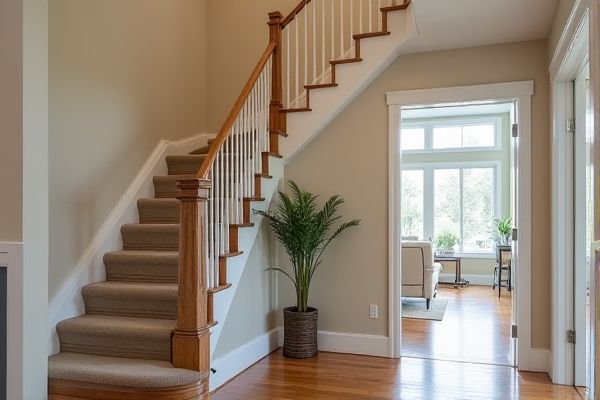
High-back staircases provide superior support and safety by offering a taller riser that helps prevent falls, making them ideal for families with children or elderly members. Low-back staircases, while offering a more open and modern aesthetic, may sacrifice some stability; explore the rest of the article to determine which design best suits your home's needs.
Table of Comparison
| Feature | High-Back Staircase | Low-Back Staircase |
|---|---|---|
| Backrest Height | Tall, extends above hips | Short, below hips |
| Support Level | Full upper back and neck support | Lower back support only |
| Comfort | Enhanced comfort for long sitting | Suitable for short rests |
| Design | Often bulky, formal appearance | Sleek, minimalist design |
| Space Requirement | Requires more vertical space | Compact, space-saving |
| Price Range | Typically higher cost | Generally more affordable |
| Usage Context | Office chairs, executive seating | Casual seating, lightweight furniture |
Introduction to High-Back vs Low-Back Staircases
High-back staircases feature tall, supportive risers that provide enhanced safety and durability, making them ideal for areas with heavy foot traffic or where extra stability is required. Low-back staircases have shorter risers, offering a minimalist aesthetic and easier access, suitable for modern homes with a focus on open space and visual lightness. Your choice between high-back and low-back staircases impacts both the functionality and style of your staircase design, balancing safety with aesthetic preference.
Defining High-Back and Low-Back Staircases
High-back staircases feature tall, extended stringers that provide greater structural support and a dramatic visual impact, often enhancing the architectural presence of your space. Low-back staircases have shorter, minimal stringers that prioritize a sleek, open design, making them ideal for modern interiors with limited space. Choosing between high-back and low-back staircases depends on your preference for structural robustness versus an airy, minimalist aesthetic.
Aesthetic Differences and Visual Appeal
High-back staircases create a bold, dramatic visual impact with their tall, prominent backs, often serving as a focal point in interior design. Low-back staircases offer a minimalist and open aesthetic, contributing to a spacious, airy environment that enhances natural light flow. Your choice between high-back and low-back designs can significantly influence the overall ambiance and style of the space.
Space Efficiency and Functional Considerations
High-back staircases offer greater support and safety but tend to occupy more vertical and horizontal space, making them less suitable for compact areas. Low-back staircases maximize space efficiency by allowing for more open designs and better utilization of under-stair storage, ideal for smaller homes or tight spaces. Functional considerations include comfort in ascending and descending, where high-back designs provide enhanced stability while low-back staircases emphasize minimalist aesthetics and versatility.
Safety Features and User Comfort
High-back staircases provide enhanced safety features by offering greater support and reducing the risk of falls, making them ideal for users with mobility challenges. Low-back staircases prioritize a minimalist design that may sacrifice some stability but improve user comfort for those who prefer less restrictive handrails. Your choice should balance the need for safety with comfortable usability based on your specific mobility requirements.
Material Options and Durability
High-back staircases often feature robust materials such as solid wood, wrought iron, or steel, providing exceptional durability and long-lasting structural integrity. Low-back staircases commonly utilize lighter materials like aluminum or engineered wood, balancing strength with a modern, minimalistic aesthetic that may be less heavy-duty over time. Choosing between these options depends on your desired durability level and the architectural style of your space.
Installation Complexity and Cost Comparison
High-back staircases typically involve more complex installation due to their increased height and structural support requirements, resulting in higher labor costs and extended project timelines. Low-back staircases feature simpler construction and easier installation processes, often reducing overall expenses and minimizing disruption during setup. Budget considerations should account for material differences, with high-back designs generally using more resources, impacting both initial investment and maintenance costs.
Suitable Environments and Applications
High-back staircases are ideal for commercial and industrial environments where enhanced safety, structural support, and ergonomics are critical, such as factories, warehouses, and public buildings. Low-back staircases suit residential and light-use applications, offering a minimalist design that fits well in homes, small offices, and retail spaces. Selecting between high-back and low-back staircases depends on load requirements, traffic frequency, and compliance with local building codes.
Maintenance Requirements and Longevity
High-back staircases typically require more maintenance due to their intricate design and exposed structural elements, which can accumulate dust and wear over time, potentially leading to faster deterioration if not properly cared for. Low-back staircases offer easier maintenance with fewer crevices and simpler construction, resulting in longer-lasting aesthetics and structural integrity when cleaned and inspected regularly. Choosing between the two depends on balancing the desired architectural style with the homeowner's willingness to perform consistent upkeep to ensure longevity.
Making the Right Choice: High-Back or Low-Back Staircase
Choosing between a high-back staircase and a low-back staircase depends on your space, style preferences, and safety needs. High-back staircases offer enhanced support, making them ideal for homes requiring extra stability and a traditional aesthetic. Low-back staircases create an open, modern feel, perfect for maximizing light and space while still providing functional support.
 homyna.com
homyna.com